
Alocasia is a genus of rhizomatous or tuberous, broad-leaved, perennial, flowering plants from the family Araceae. There are about 90 accepted species native to tropical and subtropical Asia and eastern Australia. Around the world, many growers widely cultivate a range of hybrids and cultivars as ornamentals.
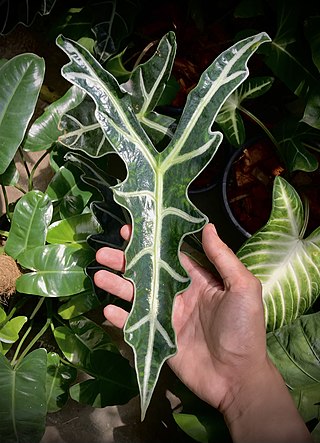
Alocasia sanderiana, commonly known as the kris plant or Sander's alocasia, is a plant in the family Araceae. It is endemic to Northern Mindanao in the Philippines, but is commonly grown as an ornamental plant worldwide. It is classified as critically endangered in the wild by the International Union for Conservation of Nature.
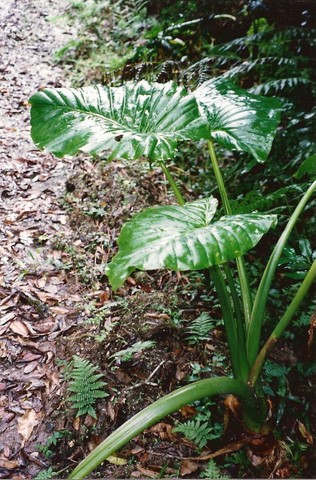
Alocasia brisbanensis, commonly known as cunjevoi or spoon lily, is a species of plant in the family Araceae native to rainforests of eastern Australia. The common name "cunjevoi" derives from the Bundjalung language of northern New South Wales.

Alocasia macrorrhizos is a species of flowering plant in the arum family (Araceae) that it is native to rainforests of Maritime Southeast Asia, New Guinea, and Queensland and has long been cultivated in South Asia, the Philippines, many Pacific islands, and elsewhere in the tropics. Common names include giant taro, giant alocasia, ʻape, biga, and pia. In Australia it is known as the cunjevoi.
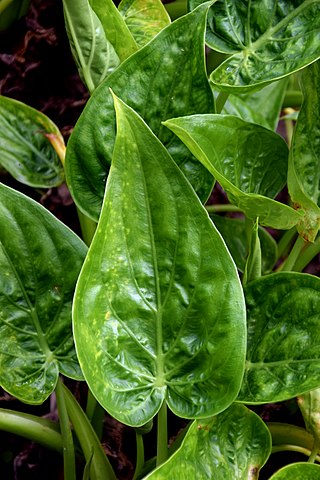
Alocasia cucullata is a species of flowering plant in the arum family known by the common names Chinese taro, Chinese ape, Buddha's hand, and hooded dwarf elephant ear. It is kept as an ornamental plant.

Alocasia sinuata, commonly known as Alocasia quilted dreams or Alocasia 'Bullata', is a flowering plant in the family Araceae. It is endemic to the limestone forests of Samar, Leyte, and parts of Mindanao in the Philippines. It is classified as critically endangered by the International Union for Conservation of Nature. Despite its critically endangered status, it is grown commonly as a houseplant.
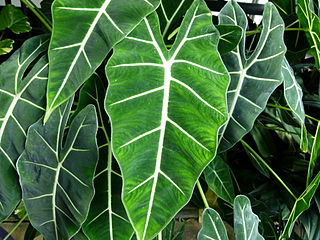
Alocasia micholitziana, commonly known as the green velvet taro or green velvet alocasia, is a plant in the family Araceae. It is endemic to the island of Luzon in the Philippines. It is commonly grown as an ornamental plant worldwide.
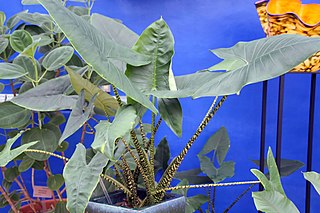
Alocasia zebrina, commonly known as the zebra plant or zebrina alocasia, is a plant in the family Araceae. It is endemic to the islands of Luzon, Mindanao, Leyte, Samar, Biliran, and Alabat in the Philippines. It is commonly grown as an ornamental plant worldwide. It is also locally known as gabing tigre in Tagalog. It is nationally listed as a threatened species and collection of A. zebrina from the wild is illegal in the Philippines.
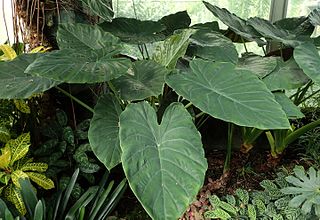
Alocasia wentii, the hardy elephant's ear, is a species of flowering plant in the family Araceae, native to the highlands of New Guinea. Occasionally kept as a houseplant, the unimproved species and some variegated cultivars are commercially available.
Alocasia infernalis is a species of flowering plant in the family Araceae, native to Kalimantan, Indonesia and Sarawak state, Malaysia. It gets its specific epithet from its dark leaves—nearly black with purple veins—that exhibit a baleful red iridescence depending on the angle of the light and the position of the viewer. Occasionally kept as a houseplant, it has been nicknamed "Black Magic". Other names associated with Alocasia infernalis, which may represent incipient common names, or cultivars, include "Black Panther", 'Kapit', and 'Viery'.
Alocasia gageana, the dwarf upright elephant ear or dwarf taro, is a species of flowering plant in the family Araceae, native to the Kachin Hills of Myanmar. Reaching 4 ft (1 m), it is only a dwarf when compared to the giant upright elephant ear Alocasia odora or to taro. It makes for a large houseplant, or an outdoor ornamental plant in tropical or (nearly) frost-free subtropical areas.

Alocasia nebula is a species of flowering plant in the family Araceae, native to Sarawak state, Malaysia. As a houseplant it is said to be the most difficult Alocasia to grow.
Alocasia melo is a species of flowering plant in the family Araceae, native to Sabah state in Malaysia. It grows on ultramafic soils. In the houseplant trade it is often sold as "Alocasia rugosa" due to its highly rugose leaves.
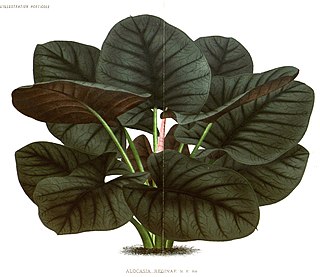
Alocasia reginae is a species of flowering plant in the family Araceae, native to Borneo. Occasionally kept as a houseplant, there are cultivars available, including 'Miri' and 'Elaine'.
Alocasia azlanii, the red mambo, is a species of flowering plant in the family Araceae, native to Brunei, and first described in 2016. With its red to purple patterning on and near its leaf veins, it is sometimes kept as a houseplant.

Alocasia portei is a species of flowering plant in the family Araceae, native to Luzon in the Philippines. With Alocasia odora it is the pollen parent of the large landscaping plant Alocasia × portora.

Alocasia sarawakensis is a species of flowering plant in the elephant ear genus Alocasia, native to Borneo. Unusually for an aroid, it is a freshwater swamp forest obligate, preferring well-lit situations. A large species, it can reach 8 ft (2.4 m). A cultivar, 'Yucatan Princess', is commercially available.

Alocasia brancifolia is a species of flowering plant in the family Araceae, native to the Moluccas and New Guinea. With its heavily dissected leaves it is sometimes kept as a houseplant. There appears to be a cultivar, 'Pink Passion', in which the markings on the petioles are pink instead of the usual brown.
Alocasia scalprum, the Samar lance, is a species of flowering plant in the family Araceae, native to Samar island, the Philippines. Well known from cultivation as a houseplant in the Philippines, and introduced to aroid enthusiasts as Alocasia cv. Samar Lance in 1984, it was not formally described as a species until 1999. Its glossy, lance-shaped leaves with embossed veins take on a blue sheen when mature. It is similar in appearance to Alocasia heterophylla.
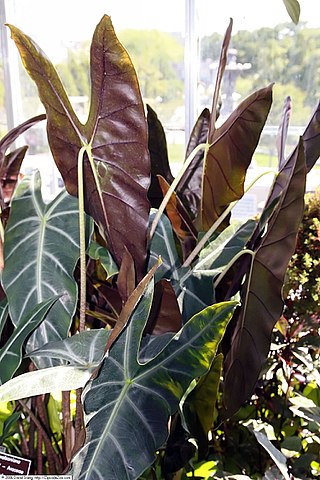
Alocasia longiloba is a species of flowering plant in the family Araceae. It is the namesake of a species complex. The complex has a widespread distribution; Guangdong, Hainan, and southern Yunnan in China, mainland Southeast Asia, and western and central Malesia.















